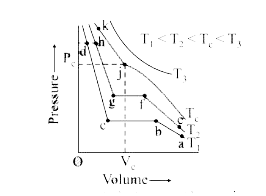How does condensation take place?
Step-by-Step Solution:
1. Definition of Condensation:
- Condensation is the process where water vapor (gas) changes into liquid water. This occurs when the temperature of the vapor decreases or when the vapor becomes saturated.
2. Reverse of Evaporation:
- It is important to understand that condensation is the opposite of evaporation. While evaporation involves the transformation of liquid water into vapor, condensation involves the transformation of vapor back into liquid.
3. Conditions for Condensation:
- There are two primary conditions under which condensation occurs:
- Cooling of Air: The air can be cooled to its dew point temperature. The dew point is the temperature at which air becomes saturated with water vapor, leading to condensation.
- Saturation of Air: The air can become saturated with water vapor, meaning it has reached its maximum capacity for holding water vapor. When the air cannot hold any more water vapor, the excess vapor condenses into liquid water.
4. Visual Representation:
- Condensation can often be observed in everyday life, such as when water droplets form on the outside of a cold glass or when dew forms on grass in the morning.
5. Conclusion:
- In summary, condensation occurs when water vapor cools to its dew point or when the air becomes saturated with water vapor, resulting in the transformation of vapor into liquid water.
---
- Condensation is the process where water vapor (gas) changes into liquid water. This occurs when the temperature of the vapor decreases or when the vapor becomes saturated.
- It is important to understand that condensation is the opposite of evaporation. While evaporation involves the transformation of liquid water into vapor, condensation involves the transformation of vapor back into liquid.
- There are two primary conditions under which condensation occurs:
- Cooling of Air: The air can be cooled to its dew point temperature. The dew point is the temperature at which air becomes saturated with water vapor, leading to condensation.
- Saturation of Air: The air can become saturated with water vapor, meaning it has reached its maximum capacity for holding water vapor. When the air cannot hold any more water vapor, the excess vapor condenses into liquid water.
- Condensation can often be observed in everyday life, such as when water droplets form on the outside of a cold glass or when dew forms on grass in the morning.
- In summary, condensation occurs when water vapor cools to its dew point or when the air becomes saturated with water vapor, resulting in the transformation of vapor into liquid water.
Similar Questions
How does fertilisation take place? Fertilisation occurs once in a month. Comment.
View SolutionWhat type of condensation takes place in the formation of the polyester from these compounds?
View SolutionHow does refraction take place in the atmosphere? Why do stars twinkle but not the planets?
View SolutionDescribe the urinary system in humans. How does urine formation take place in humans?
View SolutionWhen aniline reacts with oil of bitter almonds (C6H5CHO) condensation takes place and benzal derivative is formed This in knkown as .
View SolutionIsotherms of carbon dioxide at various temperatures are represented in figure. Answer the following questions based on this figure.

Will condensation take place when the temperature is T3?
View SolutionWhat is air pollution? How does this pollution take place?
View SolutionHow does energy change take place in a physical change? Explain.
View SolutionWhere does fertilisation take place in a flower?
View SolutionWhere does fertilisation takes place in earthworm ?
View Solution
